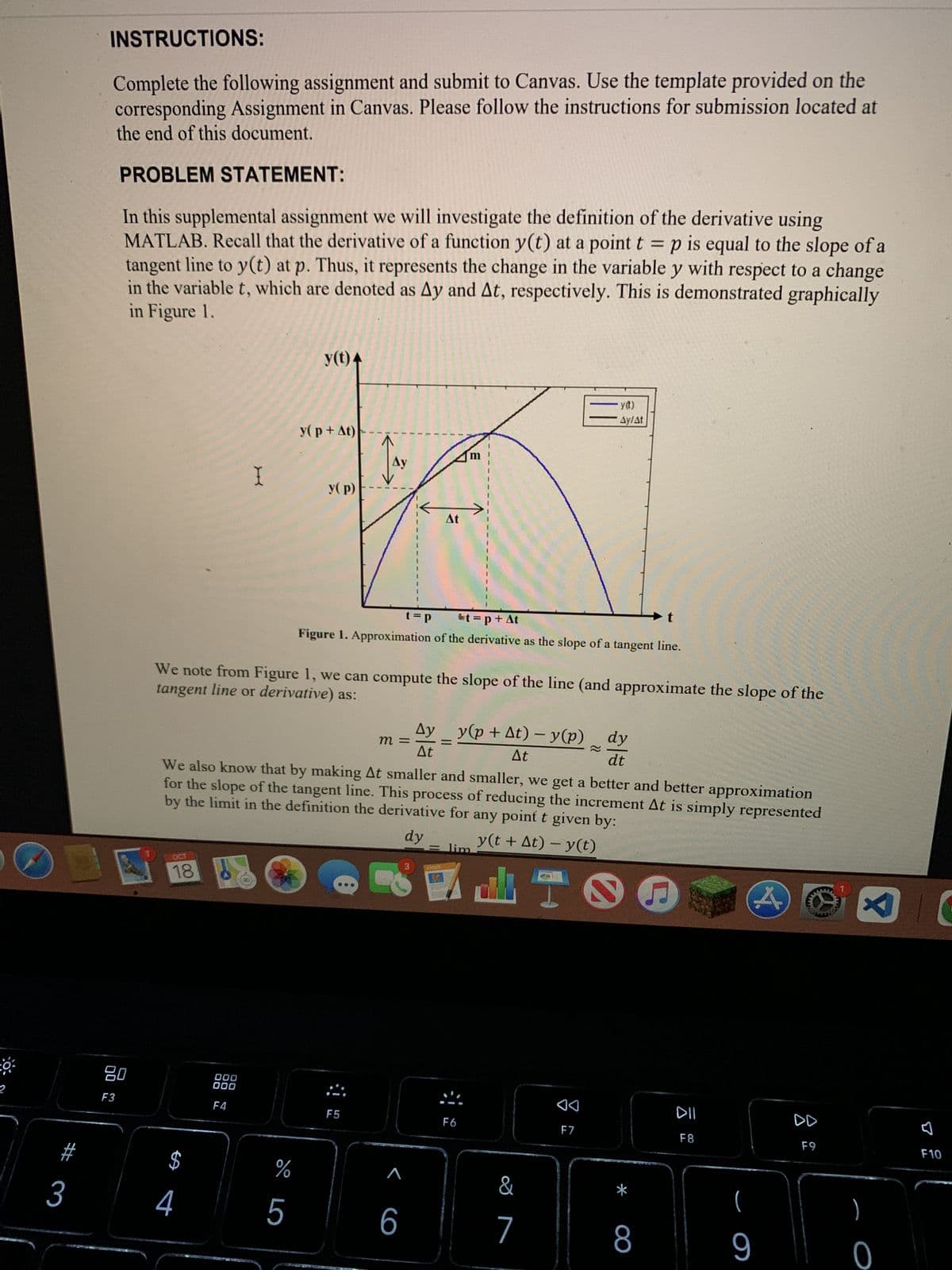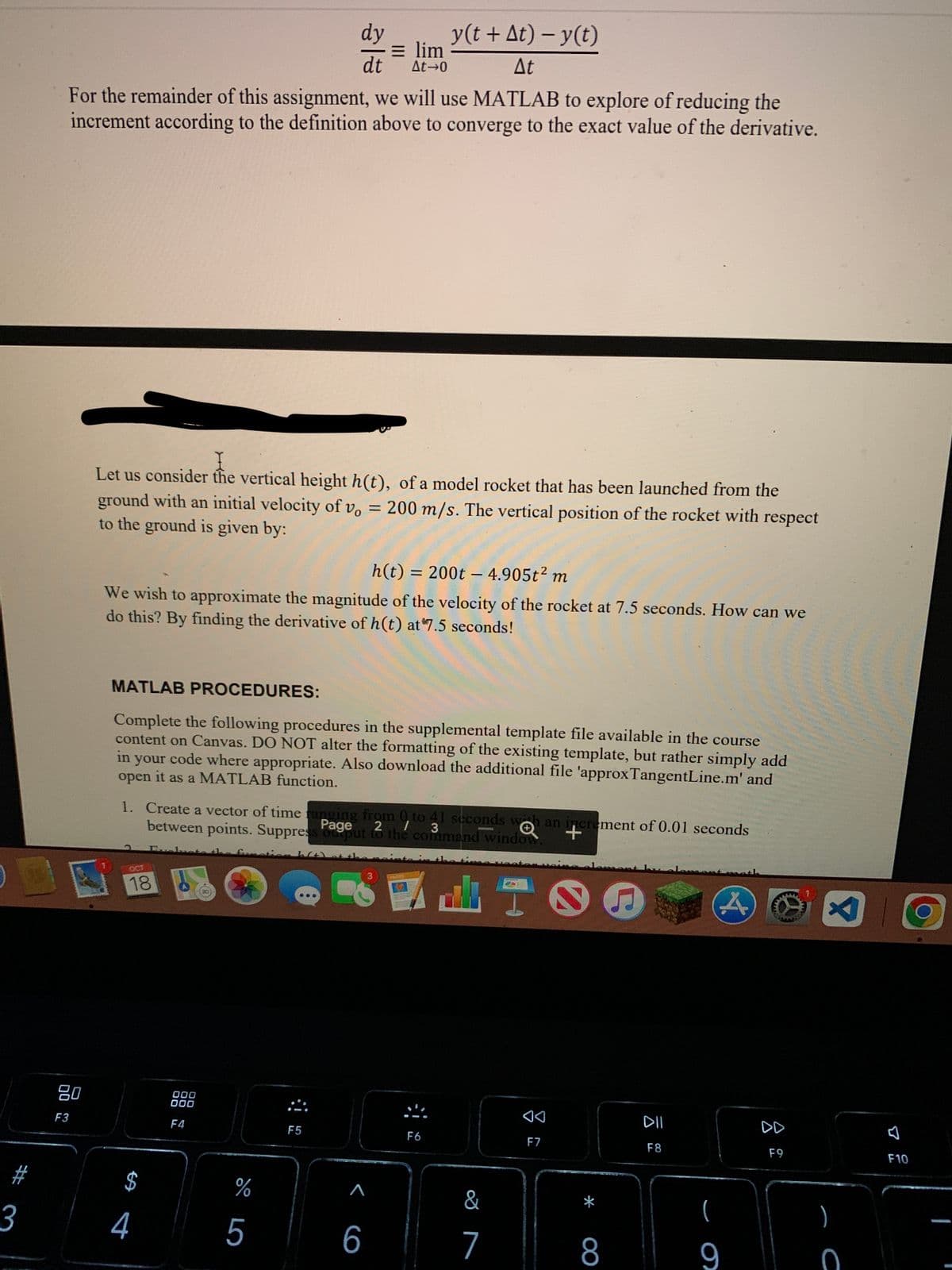1. Create a vector of time ranging from 0 to 41 seconds with an increment of 0.01 seconds between points. Suppress output to the command window. 2. Evaluate the function ℎ(??) at the points in the time vector using element-by-element math. Suppress output to the command window. 3. Create a new figure window and plot the height versus time of the rocket. Be sure to include appropriate labels and units for the x and y axes.
1. Create a
2. Evaluate the function ℎ(??) at the points in the time vector using element-by-element math. Suppress output to the command window.
3. Create a new figure window and plot the height versus time of the rocket. Be sure to include appropriate labels and units for the x and y axes.
4. Since we are concerned with approximating the derivative of the height at the critical time of ???? = 7.5 seconds, define this time value as a scalar variable and evaluate the height at this point. DO NOT suppress output to the command window.
5. In order to approximate the derivative at the critical time, we should move forward in time some increment ∆?? away from the critical point as previously demonstrated in Figure 1. We would like to explore the effect of moving forward by different amounts. Create a vector that contains increments corresponding to 20, 15, 10, 5, and 1 second forward in time. DO NOT suppress command window output.
6. According to the equation for the approximation of the derivative, we need to determine the incremental change in height that results from an incremental change in time. Thus, compute the values of the height corresponding to the incremental change in time. That is, use element-by-element math to find: ℎ(???? + ∆??) = 200(???? + ∆??) − 4.905(???? + ∆??)2 DO NOT suppress output to the command window.
7. Now determine the incremental change in height by using element-by-element math to subtract the height at the critical point from the heights evaluated at the critical point plus the increments. ∆ℎ = ℎ(???? + ∆??) − ℎ(????) DO NOT suppress output to the command window. GEEN 2010: Engineering Tools and Analysis
8. We can now approximate the slope of the tangent line according to the equation given for the approximate derivative earlier. Do this using element-by-element math and DO NOT suppress command window output. The results in your output correspond to approximations of the derivative at the critical time for decreasing values of the increment in time.
9. We now use the supplied function approxTangentLine() to plot lines corresponding to the approximations of the tangent lines we have just computed. Type 'help approxTangentLine' in the command window for information for how to use the function and complete parts (a) through (e) below. a. Create a tangent line for the first approximate value of the derivative. Make this plot a black line ('k') and run the code after you have done so. Observe the plot. b. Create a tangent line for the second approximate value of the derivative. Make this plot a red line ('r') and rerun the code after you have done so. Observe the plot. c. Create a tangent line for the third approximate value of the derivative. Make this plot a blue line ('b') and rerun the code after you have done so. Observe the plot. d. Create a tangent line for the fourth approximate value of the derivative. Make this plot a cyan line ('c') and rerun the code after you have done so. Observe the plot. e. Create a tangent line for the fifth approximate value of the derivative. Make this plot a green line ('g') and rerun the code after you have done so. Observe the plot.
10. What did you observe about the tangent lines in the previous part? What are they converging towards? Answer this as a comment in the template file.
11. Take the derivative with respect to ?? of ℎ(??) analytically and evaluate it at the critical point in time. Is this value close to the approximations you made? DO NOT suppress output to the command window.
12. Add another element to the vector in Part (5) with a value smaller than 1.0 and rerun the code. Note the new approximation for the derivative in the output to Part (8) corresponding to this point. Begin to reduce this increment, each time rerunning the code and noting the output. How small should this value be such that the approximation is accurate to within two decimals of the exact value of the derivative? Leave this value in your final code


Trending now
This is a popular solution!
Step by step
Solved in 2 steps with 2 images









